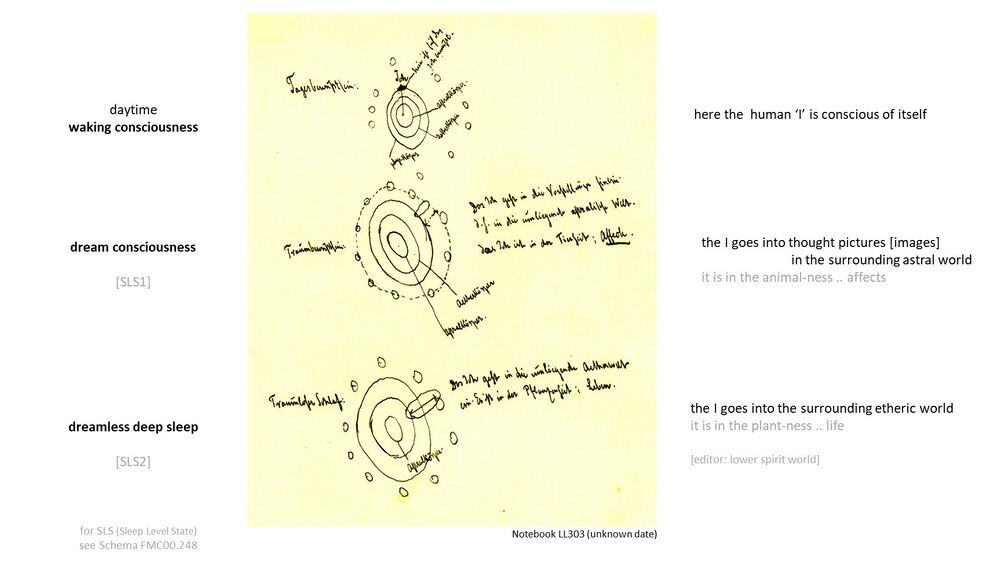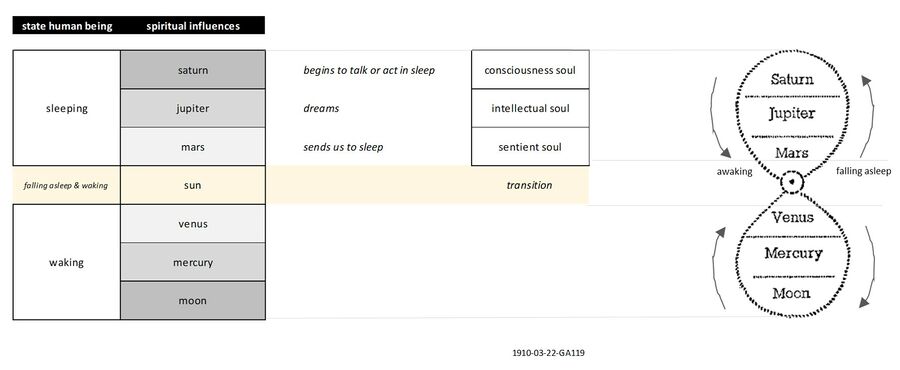Three levels of sleep
Note: this page focuses strictly on the Three levels of sleep, for a broader view on the Sleep process please see: What takes place as we sleep
During Man's sleep state, three levels or types of sleep can be distinguished, that relate to the three different worlds of consciousness that Man's astral body and I experience:
- light sleep (SLS1), dreaming can occur, here the soul is submerged in the astral world of thinking and imaginations. Today this is also known as the REM-sleep, for 'rapid eye movement' that occurs in the period when dreaming occurs.
- dreamless sleep (SLS2), no dreaming occurs unless one has received special training, and the soul is in the lower spirit world of feeling and inspirations
- even deeper sleep (SLS3)
Aspects
- brain activity as measured by ElectroEncephaloGram (EEG), shows that REM sleep is characterized, just as waking consciousness, by the fastest Beta (15-30Hz) oscillations, whereas non REM sleep is characterized by the Theta (4-8 Hz) waves, and during deep sleep: Delta (1-3 Hz) waves.
Illustrations
FMC00.248 provides a synthesis linking the three levels of sleep or Sleep States (SLS1 to 3) to the different worlds: the astral world and lower and higher spirit world.
Compare with the notebook entry lower left of FMC00.339A on Rudolf Steiner's Gesamtausgabe (GA).
Schema FMC00.664: shows a notebook (NB) entry by Rudolf Steiner depicting three states of human consciousness that Man knows from experience: daytime waking consciousness, dream, and dreamless (sleep level states SLS1 and SLS2 on Schema FMC00.248).
The three concentric circles represent the physical, etheric, and astral bodies; with the human 'I' as the point in the center.
With this presentation, note the animal group souls are in the astral world, the etheric life principle as in the plant archetypes relates to the lower spirit world, the mineral physical relates to the higher spirit world - see also Schema FMC00.518.
Schema FMC00.388 shows how our states of consciousness can be mapped to the planetary system and the influences from the different spheres.
Schema FMC00.245 illustrates how the soul and spirit live in Man's bodily principles and I-organization. How the threefold soul activity and thinking feeling willing relates to the bodily organisms, and our contemporary waking consciousness is just a part of this. Man is actually asleep in part of his bodily constitution and functioning.
Lecture coverage and references
GA036
.. contains the essay On the life of the soul' which provides the bridge between sleeping and dreaming, and daytime waking consciousness, regarded as the life of the Human 'I' soul experience. This is a study topic in it's own right, hence only short extracts below as pointers.
from: 'The human soul in the light of spirit vision
If one resorts to dream phenomena in order to acquire knowledge of the soul's nature, one ultimately is forced to admit that the object of one's search is wearing a mask. Behind the symbolizations of bodily conditions and processes, behind the fantastically connected memory experiences, one may surmise the soul's activity. It cannot be maintained, however, that one is face to face with the true form of the soul.
On awaking, one realizes how the active part of the dream is interwoven with the function of the body and thereby subject to the external world of nature. Through the backward-directed view of self-observation one sees in the soul life only the images of the external world, not the life of the soul itself. The soul eludes the ordinary consciousness at the very moment one would grasp it cognitively.
By studying dreams one cannot hope to arrive at the reality of the soul element. In order to preserve the soul activity in its innate form one would have to obliterate, through a strong inner activity, the symbolizations of the bodily conditions and processes, along with the memory of past experiences. Then one would have to be able to study that which had been retained. This is impossible. For the dreamer is in a passive state. He cannot undertake any autonomous activity. With the disappearance of the soul's mask, the sensation of one's own self disappears also.
...
To the soul's true vision, achieved in the way described, the human body can be felt [empfunden] only as the image of the human soul which is spiritual.
In dreams, the soul activity is loosened from its firm union with the body, which it maintains in the ordinary waking state; it still retains, however, the loose relationship that fills it with the symbolic images of bodily senses and with the memory experiences that also are acquired through the body. In spiritual vision of itself the soul so grows in strength that its own higher reality becomes discernible, and the body becomes recognizable in its character of a reflected image of this reality.
from 'The human soul on the path to self-observation':
In a dream the soul comprehends itself in a fleeting form, which is really a mask. In dreamless sleep it apparently loses itself entirely. In spiritual self-contemplation [Anschaung], which is achieved through circumspect reconstruction [besonnen] of the dream-state, the soul comes into its own as a creative being, of which the physical body is the reflected image.
A dream, however, arises out of sleep. Whoever undertakes to raise the dream up into the clear light of consciousness must also feel the incentive to go still further. He does this when he tries consciously to experience dreamless sleep.
That seems to be impossible, precisely because in sleep consciousness ceases. The desire consciously to experience unconsciousness seems like folly.
The folly, however, takes on another light when one confronts the memories one can follow from a given point of time backward to one's last awakening. To do so one must proceed in such a way as to connect the memory pictures vividly with that which they recall. Then, if one tries — working backward — to proceed to the next conscious memory picture before that, this will be found before the last falling asleep. If one has really made the connection vivid with what is recalled, there arises an inner difficulty. One cannot join up the memory picture after awaking with the one before falling asleep.
Ordinary consciousness gets one over this difficulty by not vividly connecting what is recalled, but simply placing the waking image next to the image one has on falling asleep. The person who has raised his consciousness to a high degree of sensitiveness, however, through conscious imitation of the dream, finds that the two images fall apart from one another [fallen ausenander]. For him an abyss lies between them, but because he notices this abyss it already begins to fill itself up. For his self-awareness the dreamless sleep ceases to be an empty passage of time. Out of it there emerges like a memory a spiritual content of the “empty time,” like a memory, it is true, of something that ordinary consciousness had not contained before. Even so this memory points to an experience of one's own soul like an ordinary memory. The soul, however, really looks thereby into that which in ordinary experience — in dreamless sleep — occurred unconsciously.
On this path the soul looks still more deeply within than it does in the condition that arises as a result of the conscious dream imitation. In this condition the soul beholds its own body-forming being. Through the conscious penetration of dreamless sleep, the soul perceives itself in its own being, completely detached from the body.
Now, however, the soul beholds not only the forming of the body but also, beyond that, the formation of its own willing [Wollen].
The inner nature of the will remains as unknown to ordinary consciousness as the events of dreamless sleep. One experiences a thought that contains the intention of the will. This thought sinks into the obscure world of the feelings and disappears into the darkness of the bodily processes. It emerges again as the external bodily process of an arm movement that is comprehended anew through a thought. Between the two thought contents there lies something like the sleep between the thoughts before falling asleep and those after waking.
Now as the inner working of the soul upon the body becomes comprehensible to the first level of vision, so does the will over and above the body to the second. The soul can follow the path to behold its inner working upon the body's organic development; and it can take the other path by which it learns to comprehend how the soul works on the body in such a way as to extract the will from it.
And just as dreaming lies between sleeping and waking, so feeling lies between willing and thinking. On the same path that leads to the illumination of the will process lies the illumination of the world of feeling also.
1922-03-24-GA211
1922-08-30-GA214
1922-10-09-GA218
.. is called 'The Experiences of Sleep and their Spiritual Background'
Discussion
Related pages
- What takes place as we sleep
- Christ Module 16 - During sleep
- Process of waking and sleeping
- Rhythm of a day
References and further reading
See section: Process of waking and sleeping#References and further reading




